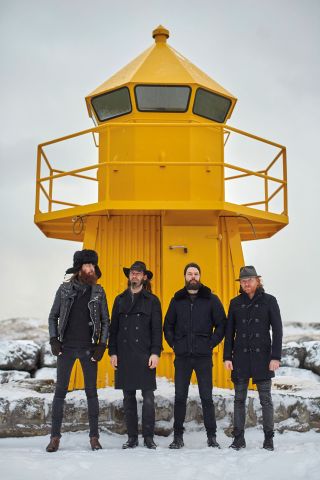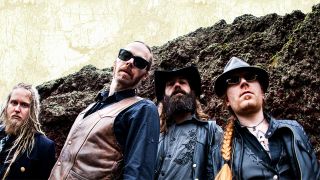On the morning of January 16, 1995, the population of Iceland woke to tragic news. An avalanche had hit the fishing village of Súðavík in the far north-east of the country in the dead of night, killing 14 people. Avalanches are frequent in Iceland, but they rarely result in the loss of life – and certainly not on such a scale.
Ten months later, on October 26, a second avalanche struck the village of Flateyri, just 20 miles from Súðavík. This time 20 people died, crushed by an unstoppable wall of snow and rock. With electricity cables snapped and the town plunged into darkness, it took rescuers two days to recover the bodies. The country went into mourning: Iceland was a small, insular place, and this was a terrible blow to the national psyche.
Sólstafir frontman Aðalbjörn ‘Addi’ Tryggvason remembers these natural disasters well. He had grown up nearby, and he knew the area.
“Words can’t describe how tragic it was,” says Addi today. “Those were small towns, a couple of hundred people, so it was a big percentage of people who were killed. I felt connected to these towns, these villages.”
Twenty-two years on, Addi has tapped into the memory of these twin tragedies for Hvít Sæng, a track on his band’s spectacular new album, Berdreyminn. The song’s title roughly translates as ‘White Blanket’ – a none-too-oblique reference to the avalanches that had such fatal consequences.
The English translation of Hvit Sæng is probably the only obvious thing about Sólstafir. They’ve built a career out of the un-obvious, taking music to strange and remote places, leaving fresh footprints in virgin snow. It’s metal, Jonsi, but not as we know it.
It’s incorrect to call Sólstafir the ‘best band you’ve never heard of’, because the chances are you have heard of them, even if you’ve never heard them. The Reykjavik band’s last album, 2014’s Ótta, bridged the worlds of metal and hipsterdom. It positioned them in a unique place, somewhere between metal, post-rock, goth and the soundtrack to the iciest nature documentary you’ve ever heard.
Berdreyminn doesn’t so much pick up where Ótta left off as veer off in a completely different direction. Where that record was windswept and expansive, its follow-up is both more diverse (obvious influences are Fields Of The Nephilim, The Mission and The Sisters Of Mercy, less obvious influences are Ennio Morricone and late country troubadour Townes Van Zandt) and more claustrophobic. But then according to Addi, it was born of darkness.
“We write about the love of death and the death of love,” he says. “Lately we’ve been tapping into desperation, mental disorders, mental abuse. We all have friends who have lost the battle and taken their own lives, or who have been in abusive relationships and come out of it really scarred, or people who do too many drugs and lose the ability to love.” He laughs. “It’s not happy music. I fucking hate happy stuff.”
We’ll have to take his word on that. Not only do Sólstafir sing in Icelandic, but Addi occasionally throws in the odd made-up phrase for good measure. With no translations available (a request to the record company for English versions of the lyrics is politely turned down), the net effect is like watching an arthouse Scandi-noir movie with the subtitles off and the sound turned up full blast.

The weird thing is that it doesn’t make the slightest difference. Quite the opposite – it’s one of the band’s defining characteristics. With their oh-so-Nordic beards’n’plaits and leather cowboy hats, they’re part Viking berserkers, part spaghetti western heroes. It’s the enigma and otherworldliness that surrounds them that could, counter-intuitively, take them beyond the realms of the cult and into the arena of rock stardom.
“I don’t know if we want to be rock stars,” says Addi cautiously. “I still see us as an underground band. I mean, I like big stages, and who wouldn’t want to sell a million records, but at heart I’m still the 17-year-old Slayer fan. As a band, we’re not really confident. I’m confident about our music, ’cos the music we write is our favourite music, but all the other stuff, that’s a big jump.”
Ironically, Addi himself is a long way from enigmatic or otherworldly. The hyperactive, bearded 30-something sitting at the other end of a Skype video call is a world away from the coiled, cowboy-hatted figure onstage. He’s drily funny (“What is there to do in Iceland growing up? Have sex with sheep”). He hasn’t drunk alcohol or taken drugs for a few years now.
“I’m done with drugs and drinking abuse,” he says. “I’ve been through my struggles. Let’s just say that my drug of choice was upper drugs. I always dreamed that downer drugs would be my thing. I tried, but it wasn’t for me. Smoking weed ruined many nights. Today I live a relatively happy life.”
That happiness was upended a couple of years ago when the band fired original drummer Guðmundur ‘Gummi’ Óli Pálmason in January 2015 on the eve of a tour. The departure of a drummer can often be of minor consequence, but this was different. Addi and Gummi had been friends since childhood, and they had formed the band together (for a point in the late 90s, Sólstafir existed as a duo featuring just the two of them).
But Gummi’s departure was as acrimonious as it got. Worse, it played out in public – the drummer posted a lengthy and anguished message online, airing his grievances with the band in general and Addi in particular. Talking about it today, the singer’s voice runs through a spectrum of emotions.
“There were two teams – him and the other three of us,” he says, somewhere between angry and dejected. “Every day was terrible. Things had been bad for a long while, but we were willing to carry on and sweep it under a rock – you’re a band, you can get over everything.”
In Addi’s telling, the breaking point came when relationships worsened between the drummer and bassist Svavar ‘Svabbi’ Austmann. “I had had personal conflicts with Gummi years before,” says Addi. “We had that sort of love/hate relationship, the Hetfield/Ulrich thing. But the bond between the two of them turned into pure hatred. The band was just being contaminated.”
Gummi didn’t take being fired from the band he co-founded well. As well as his long online missive, in which he accused his former friend of stealing the rights to the band’s name, he also unsuccessfully sued his former bandmates. Has Addi spoken to him since it all went down?
He snorts. “Man, I haven’t spoken to him in three years.”

It’s jarring hearing Addi talk about such legal torments. There’s a weird disconnect between Sólstafir’s music and reality. The likes of Silfur-Refur (‘Silver Fox’) and the epic Dýrafjörður (named after a fjord in Iceland, but also a reference to a local saying that’s the equivalent of “all roads lead to Rome” – “it means certain things are about to happen, no matter what you think or do,” says Addi) exist in a kind of half-world between two realms. Even the album’s title has an air of otherness: ‘Berdreyminn’ roughly translates as ‘Dreamer’. More specifically, the kind of dreams where the dreamer prophesises the future.
“I didn’t come up with the title,” says Addi. “But when it got brought up, I voted for it instantly. I could relate to it. As a child, I would dream of things that would then happen. People I hadn’t seen in years, I would meet them when I woke up. I was afraid to admit to myself that this was something beyond coincidence. Then you’re getting spiritual.”
This mysticism chimes with outsiders’ perceptions of Iceland. A 1998 survey suggests that 54% of the population believes they share the land with elves, trolls and assorted other mythical creatures. “Have I ever seen an elf?” says Addi wearily. “It’s the 21st century…”
But there’s no doubt that bands from Iceland are out of step with traditional musical forms, whether that’s national heroes like Björk or Sigur Rós, or Sólstafir themselves. It’s a characteristic that has served them well, and much of it is down to the country’s geographical remoteness.
“We are a fairly young nation,” says Addi. “It wasn’t until 1944 that we gained independence from Denmark. For years, no one had money here. We were living in dirt houses, eating dirt. We were a Third World country, a fucking backyard. Even when the Brits and Americans came, we were never on the touring map. We never had metal labels or clubs or anything like that. No one was gonna sign you, no one was gonna come and see you live. The only thing you did was write music in the garage for each other.”
That’s no longer the case. Iceland – its landscapes, its myths and its peculiar sense of humour – is a familiar presence these days. And with Berdreyminn, Sólstafir themselves are coming in from the cold.
Berdreyminn is out on May 26 via Season Of Mist. Sólstafir play London in June
Inspect A Norse!
A brief history of Icelandic music
14th century: The genesis of the ‘rímur’ – balladic, narrative, alliterative rhymes that would be the staple of Icelandic music for the next five or six centuries.
1966: Hljómar (Thor’s Hammer) release the groundbreaking Umbarumbamba EP, positioning themselves as Iceland’s answer to The Beatles.
1986: Pioneering indie band The Sugarcubes form from the ashes of punk band KUKL. Singer Björk later goes on to worldwide fame.
1988: HAM release their debut album, Hold, bringing together metal, goth, art rock and avant garde weirdness. The band are frequently cited as the fathers of Icelandic metal.
1999: Post-rock etherealists Sigur Rós release their breakthrough album, Ágætis Byrjun. Sólstafir claim the band as a major inspiration.
2000: Reykjavík’s post-hardcore bruisers Mínus become one of the first Icelandic rock bands to make an impact overseas, with their second album, Jesus Christ Bobby.
2005: Sólstafir release their breakthrough second album, Masterpiece Of Bitterness.
2009: The Vintage Caravan release their self-titled retro-rock debut album. The band formed three years earlier in Álftanes, when frontman Óskar Logi Ágústsson was just 12 years old.
2012: Svartidauði release their debut album, Flesh Cathedral, spearheading a new wave of Icelandic black metal.
2013: Icelandic Viking metal band Skálmöld play with the Iceland Symphony Orchestra at the Harpa concert hall in Reykjavík.
2016: Zhrine bring together the worlds of death, black, stoner and doom metal on their debut album Unortheta.
2017: Sólstafir seal their position as Iceland’s biggest metal band with Berdreyminn, the follow-up to 2014’s Ottá.




